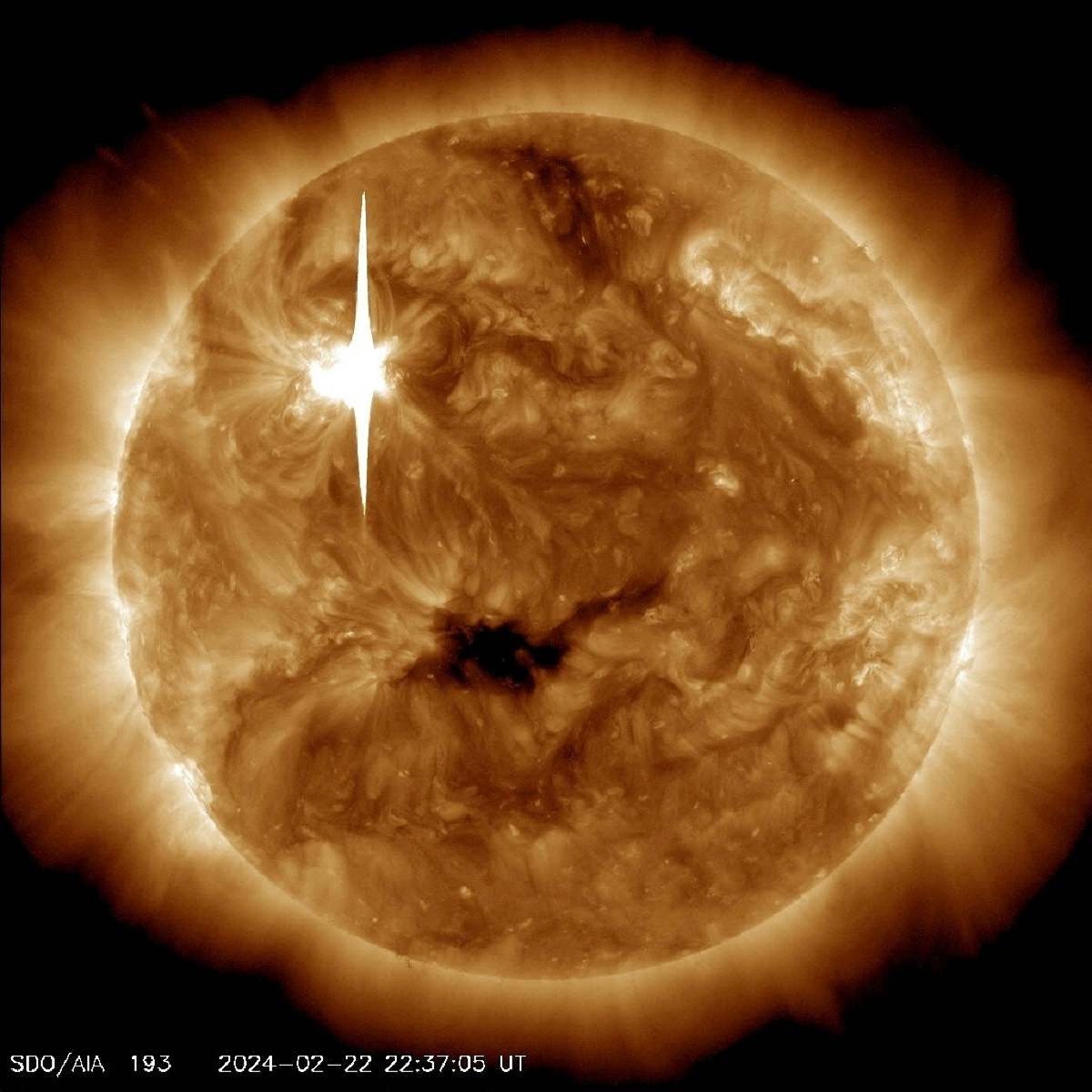
The Sun emits a solar flare on Feb. 22, in this image captured by NASA’s Solar Dynamics Observatory.
16:43 JST, May 30, 2024
WASHINGTON (Reuters) — The sun’s magnetic field, which causes solar storms like the one that hit Earth this month and produced beautiful auroras, may originate at shallower depths in the star’s interior than previously thought, according to researchers.
The sun’s outer 30% is comprised of an “ocean” of churning gases plunging more than 210,000 kilometers below the solar surface. The research, comparing new theoretical models to observations by the sun-observing SOHO spacecraft, provides strong evidence that its magnetic field is generated near the top of this ocean — less than 5% inward, or about 32,000 kilometers — rather than near the bottom, as long hypothesized.
In addition to providing insight into the sun’s dynamic processes, the findings may improve the ability to forecast solar storms and guard against potential damage to electricity grids, radio communications and orbiting satellites, the researchers said.
Most stars have magnetic fields, apparently generated by the motion of super-hot gases inside them. The sun’s ever-changing magnetic field drives the formation of sunspots — shifting dark patches — on its surface and triggers solar flares that blast hot charged particles into space.
“The top 5% to 10% of the sun is a region where the winds are perfect for making abundant magnetic fields through a fascinating astrophysical process,” said Geoffrey Vasil, an applied and computational mathematician at the University of Edinburgh in Scotland and lead author of the study published on May 22 in the journal Nature.
This process involves rotational flow patterns of super-hot ionized — electrically charged — gases called plasma inside the sun.
The precise mechanisms behind how the sun generates its magnetic field — the solar dynamo, as the scientists call it — has remained an unsolved problem in theoretical physics. These researchers hypothesize that these flow patterns are the key.
“If the plasma which constitutes the sun was completely stationary, we know the sun’s magnetic field would decay in time, and before long, there would be no sunspots or other solar activity. However, the plasma in the sun is moving around, and that motion is able to regenerate and maintain the sun’s magnetic field,” said theoretical physicist and study coauthor Daniel Lecoanet of Northwestern University in Illinois.
The solar magnetic field ebbs and flows in a distinct pattern, with sunspots — regions with very large magnetic fields — emerging and then vanishing every 11 years, making the sun, as Vasil called it, “a giant magnetic clock.”
“But we have yet to find the full story about how it happens. Complex interacting fluid motions [in this case, the solar plasma] ultimately drive a dynamo, but we can’t yet explain the details,” Vasil added.
Italian polymath Galileo carried out in 1612 the first detailed observations of sunspots using telescopes he invented. American astronomer George Hale in the early 20th century determined that sunspots were magnetic.
“And we’re still scratching our heads about these pesky sunspots,” Vasil said.
A strong solar storm that reached Earth this month caused bright auroras in the skies, though Earth’s technological infrastructure remained unscathed.
“Occasionally, a group of sunspots explodes and launches a billion tons of hot charged particles toward Earth, like what happened last week,” Vasil said.
But a powerful solar storm like one that occurred in 1859 called the Carrington Event could cause trillions of dollars in damage and leave hundreds of millions of people without power, the researchers said.
“You can think of magnetic fields as being like rubber bands. The motions near the surface of the sun can stretch out the rubber bands until they break. The breaking magnetic field can then launch material outward into space in what is called a solar storm. If we’re unlucky, these storms can be launched toward the Earth and can cause significant damage to our satellites and power grid,” Lecoanet added.
"Science & Nature" POPULAR ARTICLE
-

Mass Oyster Die-Offs Confirmed in Japan’s Seto Inland Sea; High Water Temperature Cited as Primary Cause
-

Genome Study Reveals Milestone in History of Cat Domestication
-

Big Leap in Quest to Get to Bottom of Climate Ice Mystery
-

Security Camera Footage Vulnerable to Outside Access; Investigation Finds 3,000 Pieces Exposed Online
-

Paws on Parade: Nairobi’s Dogs Dazzle at ‘Pawchella’
JN ACCESS RANKING
-

Keidanren Chairman Yoshinobu Tsutsui Visits Kashiwazaki-Kariwa Nuclear Power Plant; Inspects New Emergency Safety System
-

Imports of Rare Earths from China Facing Delays, May Be Caused by Deterioration of Japan-China Relations
-

University of Tokyo Professor Discusses Japanese Economic Security in Interview Ahead of Forum
-

Japan Pulls out of Vietnam Nuclear Project, Complicating Hanoi’s Power Plans
-

Govt Aims to Expand NISA Program Lineup, Abolish Age Restriction























